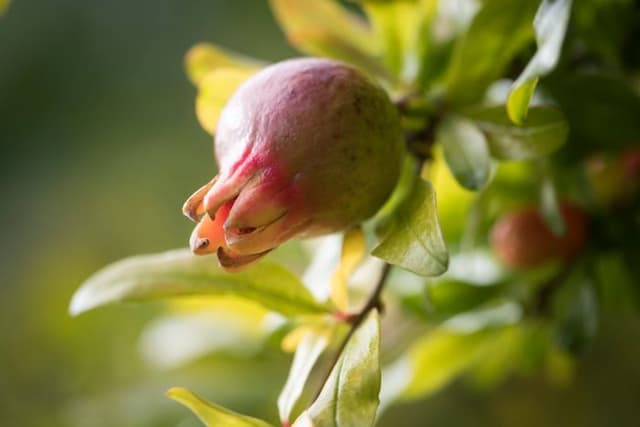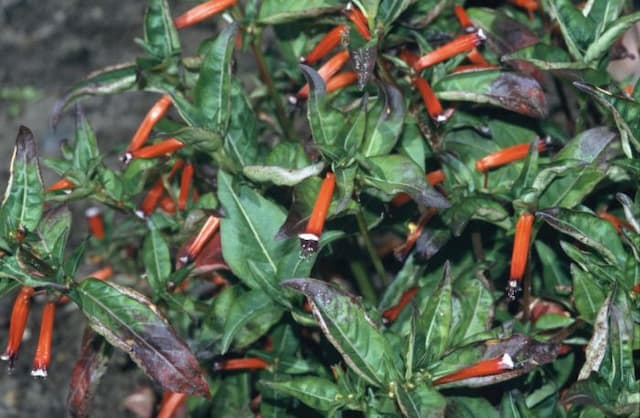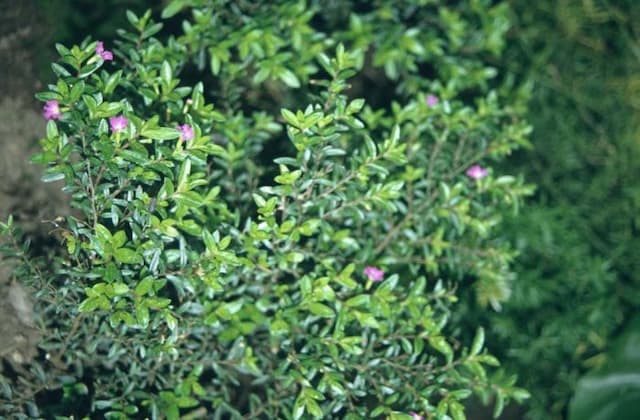Crape myrtle Lagerstroemia indica



ABOUT
Lagerstroemia indica is a deciduous shrub or small tree, typically growing between 15 and 25 feet in height, and 10 to 15 feet in width.
The bark is thin and smooth in young specimens, becoming thicker and more fissured with age.
The leaves are oval in shape and range from 1.5 to 4 inches in length. They are glossy green on top and a dull green underneath. The undersides of the leaves are covered with white, cottony hairs. The flowers of Lagerstroemia indica appear in early summer and can range from white to various shades of purple and lavender.
The flowers are showy and are borne in clusters at the tips of the branches.
The fruits are small, pointed capsules and are about 1 to 1.5 inches in length. Inside, the capsules contain numerous small, dark-brown seeds.
About this plant
 Names
NamesFamily
Myrtaceae
Synonyms
Crepe flower, Indian crape myrtle, Crepeflower, Crepe, Crape Myrtle, Pride of India
Common names
Lagerstroemia indica
 Toxicity
ToxicityTo humans
Lagerstroemia indica is not considered toxic to humans. The bark, leaves, and flowers of this plant are known to have astringent and antiseptic properties and are used in traditional medicine.
To pets
Lagerstroemia indica is generally considered to be non-toxic to animals. The plant does contain a compound called coumarins, which can cause skin irritation and irritation to the eyes, but this effect is not generally severe.
However, if eaten in large quantities, the plant can act as a mild gut irritant, resulting in nausea and vomiting. Animals ingesting this plant may experience abdominal pain and cramping, diarrhea, anorexia, dehydration, and dizziness.
 Characteristics
CharacteristicsLife cycle
Perennials
Foliage type
Deciduous
Color of leaves
Green, yellow
Flower color
Pink, purple, white
Height
Up to 25 feet
Spread
Up to 15 feet
Plant type
Tree
Hardiness zones
5
Native area
Asia
Benefits
 General Benefits
General BenefitsOrnamental Value: The Lagerstroemia indica is a colorful, subtropical tree that produces large, showy flowers. It is well suited to growing in gardens and parks to create a stunning landscaped feature.
Used as a Medicinal Plant: Traditionally, the bark, leaves and flower extracts of the Lagerstroemia indica were used by a range of cultures as a remedy to treat illnesses like malaria and reduce inflammation.
Supports Natural Ecosystems: The Lagerstroemia indica provides food and shelter for a variety of animals and insects. It is capable of fixing nitrogen in the soil and providing a nutrient source for nearby plants.
Source of Fuel: The wood of the Lagerstroemia indica can be burned for fuel, often used in cooking and heating.
Soil Retention: The roots of the Lagerstroemia indica are deep and anchoring, which helps to keep the soil moist and prevents erosion. Medical Properties
Medical PropertiesDo not use this plant as a self-medication and without consulting a doctor.
Wound Healing Properties: The leaves of Lagerstroemia indica contain flavonoids and tannins which assist in wound healing.
Antidiarrheal Properties: The root of the Lagerstroemia indica plant contains potent antidiarrheal properties which is beneficial in treating gastrointestinal disorders.
Antibacterial Properties: This plant contains polyphenols which displays antibacterial activity against several bacteria known to cause infection in humans.
Anti-Inflammatory Properties: Extracts of Lagerstroemia indica are known to display anti-inflammatory properties.
Antimalarial Properties: Lagerstroemia indica displays antimalarial activity which is beneficial in treating malaria caused by Plasmodium falciparum.
Hypolipidemic Benefits: Extracts of the Lagerstroemia indica plant are used to treat hyperlipidemia and possess hypolipidemic benefits.
Antioxidant Benefits: This plant contains high levels of antioxidants which help reduce oxidative stress and provide antioxidant benefits.
Stress Reduction Benefits: Lagerstroemia indica is known to reduce stress levels and has sedative properties.
Cardiovascular Benefits: This plant is known to have beneficial effects on the cardiovascular system.
Diabetes Management Benefits: Extracts of Lagerstroemia indica have been used to help reduce blood glucose levels and manage diabetes symptoms. Air-purifying Qualities
Air-purifying QualitiesThe Lagerstroemia indica plant is known for its air purifying qualities. It is effective at removing volatile organic compounds (VOCs) from the air, such as formaldehyde, xylene, toluene, and benzene.
Additionally, it can help to reduce airborne particles such as dust, pollen and lint. Its large leaves are capable of absorbing and filtering larger particle pollutants, while its deep roots suck up volatile organic compound pollutants from the soil. These air purifying qualities make the Lagerstroemia indica a great choice for improving air quality in an indoor environment. Other Uses
Other UsesShade Tree: Lagerstroemia indica, commonly known as the crape myrtle, can provide ample shade due to its large size.
Windbreaks: The density of the foliage and the thick trunks of the crape myrtle make it a great choice for windbreaks.
Privacy Screen: Planting several crape myrtle can create a privacy screen that can block out the views of nearby houses or roads.
Attracting Wild Birds: The bright pink, red and purple flowers of the crape myrtle attract many wild birds.
Attracting Pollinators: The flowers of the crape myrtle are a great source of nectar for pollinating insects and birds.
Fall Color: The leaves of the crape myrtle turn an attractive reddish-orange color in the fall.
Winter Interest: The gray bark of the crape myrtle is an attractive feature during the winter.
Cut Branches: Crape myrtle branches are often used in fresh bouquets or dried floral arrangements.
Interesting Facts
 Feng Shui
Feng ShuiFeng Shui practitioners recommend the Lagerstroemia indica plant be placed in the prosperity corner of the home, which is located in the far left corner of the room when standing at the entrance. Placing this plant in the prosperity corner will help to attract positive energy, good luck, and abundance.
 Zodiac Sign Compitability
Zodiac Sign CompitabilityLIBRA
Lagerstroemia indica is associated with the sign of Libra in astrology because it is a symbol of beauty, peace, and balance.
Libra is ruled by the planet Venus, which is also known as the planet of love and beauty, making it the perfect sign to match with the aesthetic nature of this flowering tree. Its blooms have a captivating, symmetrical quality to them, which makes it a beautiful representation of Libra's appreciation for balance and harmony. Plant Symbolism
Plant SymbolismThe Lagerstroemia indica is symbolic of beauty and renewal. This tropical tree is prized for its ability to flower all summer long, often producing large and dramatic blooms of various colors. Its branches, leaves and flowers have been used time and time again to symbolize beauty, femininity, hope, joy and spiritual growth.
Its most noted symbol is that of renewal. After the Crepe Myrtle loses its foliage in winter, it is reborn each spring and again blooms in the summer, symbolizing resurrection and renewal.
 Water
WaterLagerstroemia indica is a tropical shrub that requires regular watering. The best method for watering Lagerstroemia indica is to use a deep, slow watering at the base of the plant.
Watering should be done about once a week and the length of each session should take about 15 minutes. The plant should be given enough water to thoroughly moisten the soil but not enough water to create runoff or pooling water.
On average, Lagerstroemia indica should be given about 1" to 1.5" inches of water per week. Light
LightThe best light conditions for Lagerstroemia indica are bright, indirect sunlight.
A east or west-facing spot is ideal, as this will provide your plant with 6-8 hours of indirect sunlight each day. Temperature
TemperatureIn the summer, the temperature should range from 65-85° F during the day, and 55-65° F at night.
In the winter, the temperature should range from 55-65° F during the day, and 45-55° F at night. Pruning
PruningLagerstroemia indica should be pruned in late winter or early spring before new growth begins. Pruning should be done while the plant is dormant and should be light, removing no more than one-third of the plant's branches, focusing on crossing branches or deadwood. Rejuvenation pruning, which involves removing all branches except for those near the ground, is also an option if the plant is overgrown or has lost its shape. Avoid excessive pruning, as this can cause the plant to become leggy and weaken it.
 Soil
SoilFor optimal growth of Lagerstroemia indica, a soil mix of two parts loam soil, two parts coarse sand and one part compost is recommended.
The ideal soil pH for this species is between 6.0 and 6.5, so the soil mix should ideally be slightly acidic. Additionally, the soil should be well-draining, in order to prevent root rot. Humidity & Misting
Humidity & MistingThe best humidity conditions for Lagerstroemia indica is a relative humidity of 40-50%.
 Suitable locations
Suitable locationsIndoor
Not growing
Outdoor
All year round
Hardiness zone
6 - 9 USDA
 Life cycle
Life cycleThe tree begins as a seedling and can take several years to establish roots and develop into a small tree or shrub.
In the vegetative stage, the tree grows rapidly and produces dense foliage.
Once established, the crepe myrtle produces showy, crinkled flowers in shades of white, pink, purple, and red during the summer months.
After flowering, the tree produces small, hard berries that persist throughout the winter months.
In the fall, the leaves of the crepe myrtle turn a brilliant shade of orange, red, or yellow before dropping for the winter.
In the spring, new leaves emerge and the cycle begins again. Propogation
PropogationPropogation time
Spring - summer
Seed:
Seeds should be sown in late winter or early spring. The optimum temperature for germination is between 70-77°F.
Cutting:
Cuttings should be taken from young shoots or semi-hardwood shoots in summer or late winter. The cuttings should be 4-6 inches long and the base should be kept submerged in water until the roots have developed. The optimum temperature for successful rooting should be between 68-77°F. The cuttings should also be kept moist by misting on a regular basis.
 Pests
PestsSpider mite, Whitefly
 Diseases
DiseasesRoot Rot, Honey fungus




